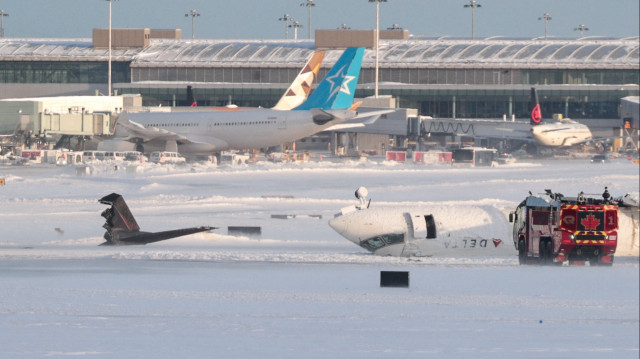Delta Plane Crash at Toronto Airport: All Details Unveiled
In a surprising twist of fate, all passengers and crew on Delta Flight 4819 survived a harrowing crash landing at Toronto Pearson International Airport despite adverse weather conditions.
Published February 19, 2025 - 00:02am

Image recovered from yenisafak.com
The aviation world was shaken on Monday when a Delta Airlines plane, identified as Flight 4819, flying from Minneapolis, experienced a critical incident upon landing at Toronto Pearson International Airport. The flight, operated by Delta subsidiary Endeavor Air, was carrying 80 passengers and crew members, all of whom survived a crash that saw the aircraft flipping and bursting into flames. The incident has raised numerous questions as experts scramble for answers.
The day teetered on the edge of disaster as the flight approached Toronto amidst inclement weather. The city was enveloped in gusting winds and snow, conditions that contributed to runway challenges. Despite these hurdles, the landing was initially unexceptional until abrupt turbulence caused the aircraft to wobble, leading to a violent landing in which it lost its right wing and ultimately flipped upside down.
Remarkably, the scenario that could have been tragically fatal resulted in no loss of life. Emergency response teams swiftly evacuated passengers, with initial reports indicating that 21 individuals were transported to local hospitals, primarily for minor injuries, and were subsequently released. Ontario Premier Doug Ford confirmed there were no casualties, underscoring the effectiveness of emergency procedures.
Eyewitness accounts from the crash have painted a vivid picture of the chaos in the moments following the incident. Pete Koukov, a passenger, captured footage of the scene, showcasing a cabin turned on its roof with passengers disembarking amidst shattered tray tables and scattered luggage. Emergency responders were seen managing the aftermath, with smoke and fuel aromas permeating the air particles.
Delta Airlines, in a public statement, expressed gratitude for the survival of all aboard and applauded the efforts of Toronto Pearson's first responders. Deborah Flint, CEO of Greater Toronto Airports Authority, highlighted the textbook response that was instrumental in avoiding fatalities. The Transportation Safety Board of Canada has taken the lead in investigating this crash, with the U.S. National Transportation Safety Board providing support.
Despite the survival of all passengers, Monday's incident marks the fourth major aviation accident in North America in recent weeks, raising concerns about aviation safety. Recent tragedies include a tragic collision near Reagan National Airport in Washington, D.C., and a crash involving a medical transport in Philadelphia, both resulting in significant casualties.
As the investigation progresses, aviation safety analysts aim to unravel the sequence of events that led to this unprecedented incident. A focal point will be the breakage of the aircraft's right wing during landing, a phenomenon rarely seen in such accidents. Ground communication records and flight data are being examined for any anomalies that could have contributed to the failure of critical components.
Weather is certainly an element under scrutiny; Toronto Pearson's recent exposure to heavy snowfall and strong winds suggests environmental factors may have played a significant role. However, officials have noted the runway conditions were managed and not atypically perilous at the time of the incident. John Cox, a veteran aviation consultant, pointed out the professionalism of aircraft design and pilot training in handling such events.
As the investigation unfolds over the coming days, the aviation community remains watchful. The runway involved will remain closed until determinations are made, facilitating a detailed examination of both the aircraft and environmental factors. Flight safety remains an ongoing global discussion, and this incident will likely become a crucial case study in preventing future accidents.
In a year already marred by multiple aviation incidents, Monday's crash highlights both the fragility and resilience of air travel today. It compels a continued focus on safety protocols and the advancement of technological measures to enhance passenger security worldwide. The future of air travel leans heavily on the lessons learned from such critical yet non-fatal incidents.






